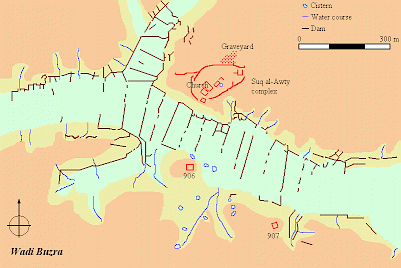Suq al-Awty
Suq al-Awty in the Wadi Buzra: Roman settlement in the Libyan desert.

Wadi Buzra is one of the many valleys in southern Tripolitana that were developed by Roman settlers, mainly after the emperor Septimius Severus had started the construction of the Limes Tripolitanus in c.200 CE. Together with the forts, hundreds of fortified farms were built (called centenaria). Agriculture, of course, was not easy in this arid zone, but to make it suitable, many dams were built. After the winter rains, when the wadis become wild flash floods, the water could be regulated.
In the valley of the Wadi Buzra, south of modern Bani Walid, you can still see the traces of these water works. They have survived because, when the farms along the Wadi Buzra were abandoned in the seventh century, there was no one left to demolish these stone structures. As a consequence, they still slow down the floods and can still be studied.

The map shows the main dams and dikes (brown), several cisterns, and three settlements. To the south are the fortified farms known as Bz 906 and Bz 907, and in the north are the buildings known as Bz 901-905.note
Suq el-Awty
On one of the northern spurs along the wadi is a large complex, known as Suq al-Awty, in which at least five constructions can be discerned, which, from north to south are: a fortified farm (Bz 902) with a cistern (Bz 903), a church (Bz 901), another fortified farm (Bz 904), and another cistern (Bz 905).

Bz 902 was the northernmost fortified centenarium. It was square and measured about 20 x 20 m, with the rooms situated around a small central square. Ceramics show that the place was settled in the second century, so it actually predates the construction of the Limes Tripolitanus. Cistern Bz 903 was close to this farm.
The southern centenarium of Suq al-Awty was called Bz 904 by the excavators. The eastern wall is extremely heavy. The building was about seventeen meter long. Access was possible through a vaulted passage; the outside was decorated. It was as old as the first centenarium. These fortified farms were surrounded by huts.

A vaulted cistern, known as Bz 905, was built on the southern slope of the hill. The structure, made of plastered rubble, must have served to collect the rain water that fell on the hill itself. It is a pretty deep structure and was erected on, not dug in the slope.
Church
The main monument of Suq al-Awty, however, is Bz 901, a real church from the Early Byzantine age. It is about 23 m long, has three barrel-vaulted aisles and is almost 13 m wide. A baptistery has been identified; water must have been obtained from the nearby cisterns. The people who visited the church, must have lived in the wide area, for example in the village now called Suq al-Fawqy, six km to the west.
The church was decororated with sculpture and frescoes. There are also some graffiti, including a representation of a water vessel - a bit odd in a small village in the desert that produced cereals and olives.
Suq al-Awty and the two centenaria were abandoned in the second half of the seventh century, which may or may not have had something to do with the Arab conquest. The church may have been a special target, although the Muslims are not known for looting the religious buildings of fellow-monotheists.
Across the wadi
There were two fortified farms on the south bank of Wadi Buzra. One of them may have had three storeys and is called Bz 906. The heavy walls, made of coursed rubble, were about a meter in diameter. There were many people living here: there were at least twelve rooms in this building, and there were many cisterns in the neighborhood. The other one, called Bz 907, is like Bz 906, but heavier. It measures about 18x17 meters.
 View across Wadi Buzra to Bz 906-907 |
 Suq al-Awty, Farm Bz 907 |
 Wadi Buzra, Farm Bz 906 |
 Suq al-Awty, Cistern Bz 905 |







